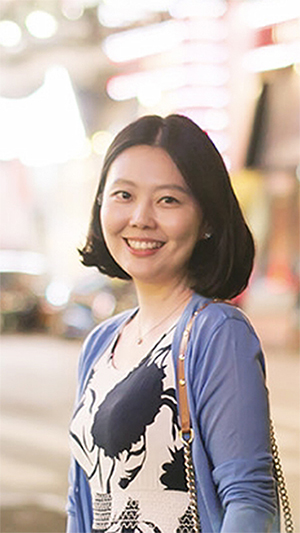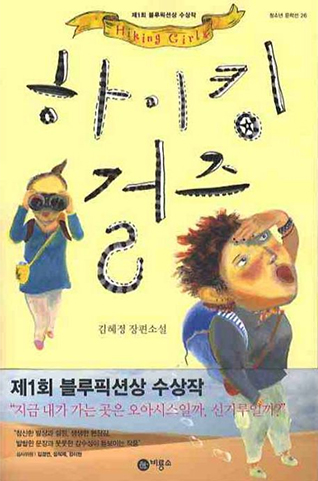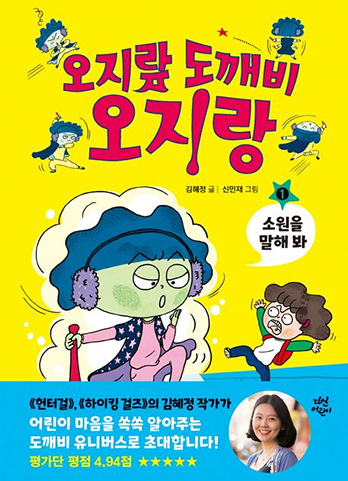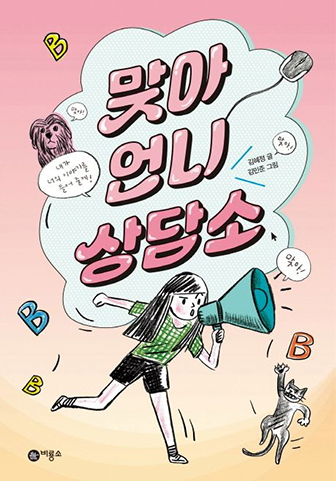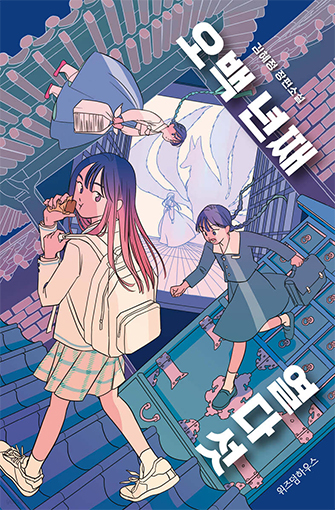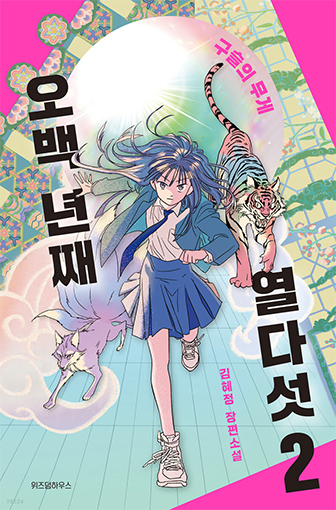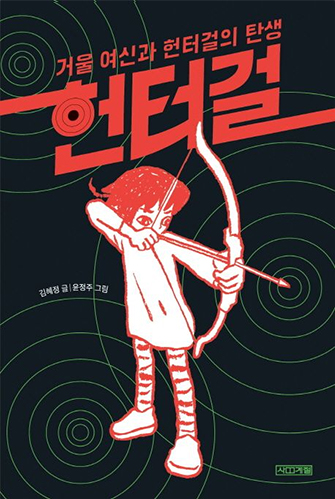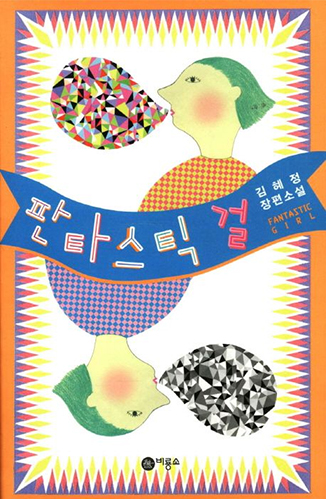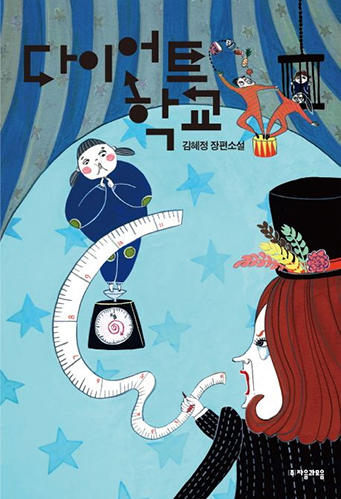|
Korean Authors
Writer Kim Hye-Jung The Story of Becoming “Me, Different from Yesterday”
2023.12.04
Adolescence is a time of imperfection, making it all the more precious and beautiful because you can envision anything you want in the future. Young adult literature also colors the minds of not only children but also adults with diverse stories that cross genres such as science fiction and fantasy. It is a genre you can pick up and read for fun, and once done, you feel deeply moved. Perhaps it is the perfect genre for Kim Hye-Jung, who became a writer because she loved stories. Listening to the inner thoughts of struggling teenagers and writing their stories with sincerity, Kim hopes that her books will give teenage readers a place to breathe. Her affectionate and warm perspective on the stories of teenagers could be felt throughout the interview. Following is an interview with Kim Hye-Jung, an artist who touches our hearts with each new story, hoping to paint a life full of the 100 colors that children possess.

It is an honor to have you with us on K-Book Trends. Please introduce yourself to our readers.
Hello, I’m Kim Hye-Jung, and I write “children’s stories” for children and “young adult fiction” for teenagers. My published works so far include young adult fiction Fifteen Years Old For 500 Years 1, 2 (Wisdom House), Fantastic Girl (BIR, the original story of the drama “Hello, It’s Me!”), Hiking Girls (BIR), and Diet School (Jamo Books), as well as children’s books Hunter Girl 1-5 (Sakyejul), Nosy Goblin Ohjirang 1-4 (Dasan Kids), and Counselor Ms. You’re Right (BIR).

You won the 1st Blue Fiction Award in 2008 for your book Hiking Girls. Since the award is for young adult literature, did you plan to write young adult fiction from the beginning? Why or how did you decide to write for young adults instead of adults?
I wanted to be a storyteller since I was a kid. I wanted to be a novelist, or a movie director, but I didn’t think I would write young adult fiction. Because when I was a teenager, there was no young adult genre in Korea. It was only in 2008 that the young adult genre started to take root in Korea. When I was in my 20s, I was submitting my work to various contests, and I came across a new award for young adult literature. I didn’t know exactly what young adult literature was, but I thought it could be anything with a teenager as the main character. And, as you said, I won the award with my story, Hiking Girls. I love teenage characters. It is because a story can change when the characters change, and teenage characters are very volatile. They have a big, dynamic emotional spectrum, and I think that is why they fit so well into different genres, such as science fiction and fantasy.
Hiking Girls, Nosy Goblin Ohjirang 1, and Counselor Ms. You’re Right

The book Fifteen Years Old For 500 Years, published in 2022, is often referred to as a “K-Fantasy” because of its Korean settings, including the myth of Dangun and the tale of Gumiho. Although the settings are very familiar to Koreans, they might be somewhat unfamiliar to international readers. Can you give us a brief description of the book and what international readers should keep in mind when reading these stories?
The idea of immortality has always been a favorite subject in both the East and the West. There are already many stories in movies and dramas about people who live forever without aging, but the main characters are usually “adults” in their 30s. The 30s are the best years of your life - you can do whatever you want, make money, and be physically the healthiest you can be. In the book Fifteen Years Old For 500 Years, the main character, Gaeul, a member of the “Yaho” tribe, is fifteen years old and has lived for five hundred years, just like it says in the title. I think “fifteen” is the most difficult and challenging age in life, the point where you wish it would just be over already.
Fifteen Years Old for 500 Years and Fifteen Years Old for 500 Years 2: The Weight of the Bead

Fifteen Years Old for 500 Years has sold 100,000 copies, and readers have been so enthusiastic that you recently released a sequel, Fifteen Years Old for 500 Years 2: The Weight of the Bead. Did you write it with a sequel in mind from the beginning? How did you come up with the story for the second volume?
I didn’t think of a sequel when I was writing the first book. Though the trend is different nowadays, fantasy was not welcomed in young adult literature two or three years ago. Before publishing Fifteen Years Old for 500 Years, I received feedback such as, “Korean teenagers don’t read fantasy,” “Write something that can be used for education,” and “I would rather change the age of the main character to elementary school students and write it as a fairy tale.” So I had a lot of doubts about whether the book would ever see the light of day, but after all the twists and turns, it came out, and it has been really well received by children and young adult readers. It has been my most popular book to date.
My goal is to write stories that I never would have written in the past.

One of the major keywords of young adult fiction is “growth.” How do you hope readers of your work will grow?
I have been a teenager, been in my 20s, and 30s, and now I’m in my 40s. No matter how much I think about it, I think the hardest period of a person’s life is the teenage years. Growing up is an amazing thing, and I think it’s a miracle, but people who have grown up think it is easy. They say that you don’t have any responsibilities, you don’t have to earn money, your parents do everything for you, so there is nothing to worry about. But I think adults who say that have a “bad memory.” It takes a lot of energy to make soft clay hard. And because teenagers have a soft heart, they are bound to get hurt a lot. Although teenage life is hard and difficult, I want them to endure it, to hang in there, and to grow up in peace. I want them to grow up without hating themselves, and instead to be kind.

It seems like a lot of adult readers are looking to young adult literature lately because it’s entertaining, but there are also parts of it that touch their hearts. Have you noticed a stronger adult readership than in the past?
When I write, my biggest goal is to write something that a fifteen-year-old Kim Hye-Jung would enjoy reading. I think that fifteen-year-old Kim Hye-Jung might exist in a parallel universe, or maybe inside of me. I love novels, dramas, and movies that feature teenagers, and it is not just because I write young adult literature. I really love stories where the protagonist goes through an event and becomes a different version of oneself a day after. Those stories still make my heart flutter. Even if I hadn’t become a writer of young adult literature, I think I would still love stories with teenagers as the protagonists. If you are an adult, but you still have that adolescent “me” in your heart, and if you still get excited about reading coming-of-age stories, I think you are a reader of young adult literature.

Writing about teenagers seems to require a great deal of knowledge and understanding of the culture of that generation. How do you do research on teen culture, and where do you find inspiration for your work?
I give a lot of middle school and high school talks - probably about 100 a year - and that is where I get a lot of my research and inspiration for the characters in my novels. Because I’m already an adult, and there are a lot of adults around me, I can’t help but have adult conversations. But when I go to a school talk, I get to think, “Oh, the fifteen-year-old in my novel must be like this kid,” with the character automatically popping up in my brain. And when I give a talk, I don’t just sit there and give a lecture, but I get to talk to teenagers about this and that. I get to learn about episodes that happened in class, things that happened after school, conflicts with friends, school festivals and events, and quite a few scenes are actually based on things I have heard and seen at school. I think if you live with the same kids every day, there is less room for imagination. So, it’s nice to see different kids every time, and to be able to make up my own little stories about them.
I think a person’s growth is something like a miracle.

The interaction between you and your readers must have been very meaningful for them as well. What kind of stories do you usually tell in your talks, and do you have any memorable moments with young readers?
I talk a lot about going through adolescence when I was a teenager, and when I was a teenager, I submitted a novel to a publisher and got a novel published called Runaway Diary (Munhak Soochup) - I think that’s the funniest thing for teenagers to hear. I tell them that I became a writer not because I was good at it, but because I loved it. And I also tell them the things that I wanted to hear when I was a teenager. I tell them not to let adults in their lives who say things like, “If you live like this, you will be screwed,” or “If you don’t do what adults tell you to do, you will be in trouble.” It’s not the adults of today who will know more about the world in 20 years, it is the teenagers of today. I don’t want the adults of today, who can paint with 24 colors, to stand in the way of the teenagers who can paint with 100 colors.

Can you recommend any of your books that you think young readers abroad would enjoy?
I would recommend Hunter Girl 1-5, Fantastic Girl, and Diet School.
Hunter Girl 1, Fantastic Girl, and Diet School

Since you love to write so much, we are eager to hear what you will write about in the future. Do you have any plans or goals for your future writing?
My goal is to write something that I wouldn’t have written five years ago. When I first started writing, I had no idea I was going to write fantasy, because all the fiction I had been taught and read up until then was all about real life. But as the characters got younger, I was able to tell science fiction and fantasy stories. I’m often asked if I find writing difficult or boring. I don’t think I ever get bored because every story I write is different. With series, it might be a few years, but it’s three years at the most, and it is fresh because I’m always telling a different story with different characters and events. It can be challenging if I can’t think of a story or if the story isn’t working out, but it is like playing a game. Eventually, you end up with a story, and it is fun.
#Kim Hye-Jung#Young adult fiction#Children’s book#Fifteen Years Old For 500 Years#K-Fantasy |
Pre Megazine
-

Jakkajungsin Publishing Co.
VOL.69
2024.04 -

Writer Yun Jung-Eun
VOL.69
2024.04 -

Jumping Books Publishing House
VOL.68
2024.03 -

Writer Kim Hwa-Jin
VOL.68
2024.03 -

Publisher Hyohyung
VOL.67
2024.02 -

Writer Minha
VOL.67
2024.02 -

Almond Publishing
VOL.66
2024.01 -

Writer Kwon Jung-Min
VOL.66
2024.01 -

Hakgojae Publishers
VOL.65
2023.12 -

Writer Kim Hye-Jung
VOL.65
2023.12 -

Eidos Publishing House
VOL.64
2023.11 -

Writer Hwang In-Chan
VOL.64
2023.11 -

Munhakdongne
VOL.63
2023.10 -

Writer Chang Kang-myoung
VOL.63
2023.10 -

Happywell Publishing
VOL.62
2023.09 -

Writer Baik Soulinne
VOL.62
2023.09 -

Dasan Contents Group (Dasan Books)
VOL.61
2023.08 -

Writer Lim Kyoung-Sun
VOL.61
2023.08 -

SpringSunshine Publishing Co.
VOL.60
2023.07 -

Writer Lee Kyung-Hye
VOL.60
2023.07 -

Human Cube
VOL.59
2023.06 -

Doctor Jeong Jae-Seung
VOL.59
2023.06 -

Anonbooks
VOL.58
2023.05 -

Writer Son Bo-Mi
VOL.58
2023.05 -

Namhaebomnal
VOL.57
2023.04 -

Writer Kim Bo-Young
VOL.57
2023.04 -

Hugo Publishing
VOL.56
2023.03 -

Writer Cho Kwang-Hee
VOL.56
2023.03 -

Balgeunmirae Publishing Co.
VOL.55
2023.02 -

Writer Lee Byung-Ryul
VOL.55
2023.02 -

Wisdom House, Inc
VOL.54
2023.01 -

Writer Jeong Jia
VOL.54
2023.01 -

Humanitas
VOL.53
2022.12 -

Writer Kim Yeon-Su
VOL.53
2022.12 -

Songsongbooks
VOL.52
2022.11 -

Writer Eun Hee-Kyung
VOL.52
2022.11 -

Bombom Publishing Co.
VOL.51
2022.10 -

Writer Jiwon Yu
VOL.51
2022.10 -

Hangilsa Publishing Co., Ltd.
VOL.50
2022.09 -

Writer Kim Won-Young
VOL.50
2022.09 -

Moksu Publishing Company
VOL.49
2022.08 -

Writer Yoo Sun-Kyong
VOL.49
2022.08 -

Next Wave
VOL.48
2022.07 -

Writer Park Sang-Young
VOL.48
2022.07 -

A Thousand Hopes
VOL.47
2022.06 -

Writer Bora Chung
VOL.47
2022.06 -

Woongjin ThinkBig
VOL.46
2022.05 -

Dr. Oh Eun-Young
VOL.46
2022.05 -

JECHEOLSO Publishing House
VOL.45
2022.04 -

Writer Jang Ryu-Jin
VOL.45
2022.04 -

Changbi Publishers
VOL.44
2022.03 -

Writer Kim Ho-Yeon
VOL.44
2022.03 -

Mati Books
VOL.43
2022.02 -

Writer Lee Kkoch-Nim
VOL.43
2022.02 -

Picturebook Gongjackso
VOL.42
2022.01 -

Writer Kim Sang-Wook
VOL.42
2022.01 -

Writer So-yeon Park
VOL.42
2022.01 -

Writer Yoo Eun sil
VOL.42
2022.01 -

Kungree Press
VOL.41
2021.12 -

Writer Kim Lily
VOL.41
2021.12 -

Writer Park Yeon-jun
VOL.41
2021.12 -

Writer Yi Hyeon
VOL.41
2021.12 -

A deeper world told through picture books 'Iyagikot Publishing (Story Flower)'
VOL.12
2019.06 -

Author Jeon Min-hee
VOL.12
2019.06 -

Illustrator Kim Hwan-Young
VOL.13
2019.07 -

Travelers sailing through the sea of knowledge - 'Across Publishing Group Inc.'
VOL.13
2019.07 -

Genre Novel Publisher 'Arzak Livres'
VOL.14
2019.08 -

Author Lee Yong-han
VOL.14
2019.08 -

Wookwan Sunim
VOL.15
2019.09 -

East-Asia Publishing
VOL.15
2019.09 -

Author Jo Jung-rae
VOL.16
2019.10 -

EunHaeng NaMu Publishing
VOL.16
2019.10 -

Writer Heo Kyo bum
VOL.40
2021.11 -

Writer Kim So-Young
VOL.40
2021.11 -

Author-illustrator Kim Sang Keun
VOL.40
2021.11 -

ACHIMDAL BOOKS
VOL.40
2021.11 -

Author Kang Gyeong-su
VOL.17
2019.11 -

Moonji Publishing Belongs to the Literary Community
VOL.17
2019.11 -

Author Kim Yun-jeong
VOL.18
2019.12 -

I-Seum
VOL.18
2019.12 -

Kim Cho-Yeop
VOL.19
2020.02 -

Creating a window into the future with books
VOL.19
2020.02 -

Author Serang Chung
VOL.20
2020.03 -

Hey Uhm
VOL.20
2020.03 -

Writer Lim Hong-Tek
VOL.21
2020.04 -

BIR
VOL.21
2020.04 -

Writer Song Mikyoung
VOL.39
2021.10 -

Author-illustrator Kim Dong Su
VOL.39
2021.10 -

Writer Lee Seula
VOL.39
2021.10 -

Tabi Books
VOL.39
2021.10 -

Writer Kim Soo-hyun
VOL.38
2021.09 -

Author-illustrator Lee Myoung Ae
VOL.38
2021.09 -

Writer Hwang Sunmi
VOL.38
2021.09 -

Kidari Publishing Co.
VOL.38
2021.09 -

Writer Sohn Won-Pyung
VOL.22
2020.05 -

Woods of Mind's Books
VOL.22
2020.05 -

Writer Heungeul
VOL.23
2020.06 -

Gloyeon
VOL.23
2020.06 -

Maumsanchaek
VOL.24
2020.07 -

Winners of the 2021 Bologna Ragazzi Award
VOL.37
2021.08 -

Picture book artist Lee Suzy
VOL.37
2021.08 -

Author-illustrator Yi Gee Eun
VOL.37
2021.08 -

Hubble
VOL.37
2021.08 -

Writer Baek Se-Hee
VOL.25
2020.08 -

Bearbooks Inc.
VOL.25
2020.08 -

Author Baek Hee-Na
VOL.26
2020.09 -

Yuksabipyoungsa
VOL.26
2020.09 -

Writer Kang Hwa-Gil
VOL.27
2020.10 -

Kinderland (Bandal)
VOL.27
2020.10 -

Writer Ha wann
VOL.36
2021.07 -

Author-illustrator Myung Soojung
VOL.36
2021.07 -

Writer Jung Yeo-Wool
VOL.36
2021.07 -

Publisher EcoLivres
VOL.36
2021.07 -

Writer Lee Geumi
VOL.28
2020.11 -

Sakyejul
VOL.28
2020.11 -

Writer Kim Keum-Hee
VOL.29
2020.12 -

Geulhangari
VOL.29
2020.12 -

Writer Cheon Seon-Ran
VOL.30
2021.01 -

Hyang Publishing House
VOL.30
2021.01 -

Writer Lee Hee-Young
VOL.31
2021.02 -

Sanzini
VOL.31
2021.02 -

Publisher Prunsoop
VOL.32
2021.03 -

Writer Sim Yun-Kyung
VOL.32
2021.03 -

Hanbit Media
VOL.35
2021.06 -

Hyeonamsa
VOL.33
2021.04 -

Author-illustrator Noh Inkyung
VOL.33
2021.04 -

Writer Cho Won-Jae
VOL.35
2021.06 -

Writer Kim Jung-Mi
VOL.34
2021.05 -

Safehouse Inc.
VOL.34
2021.05


